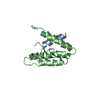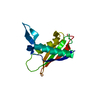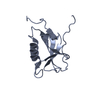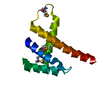登録情報 データベース : PDB / ID : 1g1eタイトル NMR STRUCTURE OF THE HUMAN MAD1 TRANSREPRESSION DOMAIN SID IN COMPLEX WITH MAMMALIAN SIN3A PAH2 DOMAIN キーワード / / 機能・相同性 分子機能 ドメイン・相同性 構成要素
/ / / / / / / / / / / / / / / / / / / / / / / / / / / / / / / / / / / / / / / / / / / / / / / / / / / / / / / / / / / / / / / / / / / / / / / / / / / / / / / / / / / / / / / / / / / / / / / / 生物種 Mus musculus (ハツカネズミ)手法 / Model type details minimized average データ登録者 Brubaker, K. / Cowley, S.M. / Huang, K. / Eisenman, R.N. / Radhakrishnan, I. ジャーナル : Cell(Cambridge,Mass.) / 年 : 2000タイトル : Solution structure of the interacting domains of the Mad-Sin3 complex: implications for recruitment of a chromatin-modifying complex.著者 : Brubaker, K. / Cowley, S.M. / Huang, K. / Loo, L. / Yochum, G.S. / Ayer, D.E. / Eisenman, R.N. / Radhakrishnan, I. 履歴 登録 2000年10月11日 登録サイト / 処理サイト 改定 1.0 2000年12月6日 Provider / タイプ 改定 1.1 2008年4月27日 Group 改定 1.2 2011年7月13日 Group 改定 1.3 2022年2月23日 Group / Database references / Derived calculationsカテゴリ database_2 / pdbx_nmr_software ... database_2 / pdbx_nmr_software / pdbx_struct_assembly / pdbx_struct_oper_list Item / _database_2.pdbx_database_accession / _pdbx_nmr_software.name改定 1.4 2024年5月22日 Group / カテゴリ / chem_comp_bond
すべて表示 表示を減らす
 データを開く
データを開く 基本情報
基本情報 要素
要素 キーワード
キーワード 機能・相同性情報
機能・相同性情報
 データ登録者
データ登録者 引用
引用 ジャーナル: Cell(Cambridge,Mass.) / 年: 2000
ジャーナル: Cell(Cambridge,Mass.) / 年: 2000 構造の表示
構造の表示 Molmil
Molmil Jmol/JSmol
Jmol/JSmol ダウンロードとリンク
ダウンロードとリンク ダウンロード
ダウンロード 1g1e.cif.gz
1g1e.cif.gz PDBx/mmCIF形式
PDBx/mmCIF形式 pdb1g1e.ent.gz
pdb1g1e.ent.gz PDB形式
PDB形式 1g1e.json.gz
1g1e.json.gz PDBx/mmJSON形式
PDBx/mmJSON形式 その他のダウンロード
その他のダウンロード 1g1e_validation.pdf.gz
1g1e_validation.pdf.gz wwPDB検証レポート
wwPDB検証レポート 1g1e_full_validation.pdf.gz
1g1e_full_validation.pdf.gz 1g1e_validation.xml.gz
1g1e_validation.xml.gz 1g1e_validation.cif.gz
1g1e_validation.cif.gz https://data.pdbj.org/pub/pdb/validation_reports/g1/1g1e
https://data.pdbj.org/pub/pdb/validation_reports/g1/1g1e ftp://data.pdbj.org/pub/pdb/validation_reports/g1/1g1e
ftp://data.pdbj.org/pub/pdb/validation_reports/g1/1g1e リンク
リンク 集合体
集合体
 要素
要素

 試料調製
試料調製 解析
解析 ムービー
ムービー コントローラー
コントローラー













 PDBj
PDBj






